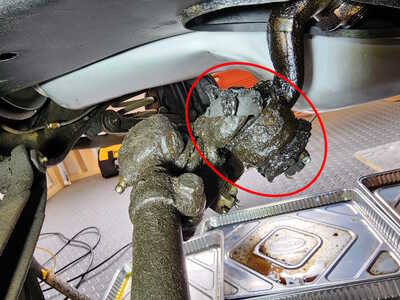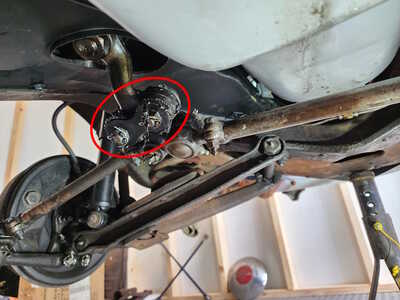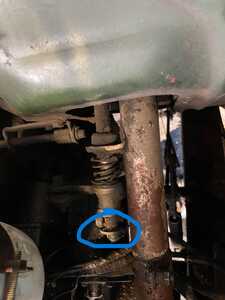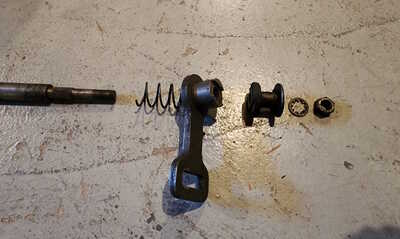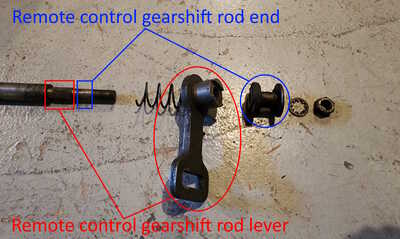Unregistered users may browse the website, but in order to participate in the forums and view select pages (such as "Club Contacts" and "Classified Ads") a user account is required. Click HERE to email the webmaster and request a free account. The National DeSoto Club uses real names rather than pseudonyms. Notify the webmaster of your user name preference (Johnathon Doe vs. John Doe, etc.), preferred email address, and password request.
I'm looking for a steering box for my 1949 1st series S11. I found a rebuilt kit as a second option. Has anyone successfully done this and how difficult is it if I have to use this option.
@Carl Nutaitis is working on his steering box for his '41 and is also simultaneously planning a rebuild on his '48 S-11. He might be able to provide some input here.
If you decide to send yours off to a rebuilder, many people use Lares Corporation in Minnesota.
You might also try posting your question on the NDC Facebook page. Such requests usually receive good advice.
Hi there @jackharrington,
I am currently in the process of completely rebuilding the front suspension, including the tie-rod ends and steering gearbox, in my 1941 DeSoto. The steering gearbox used in 1941 and 1948, (and theoretically the 1st series 1949 DeSotos), all use a Gemmer 3 steering gearbox. The 2nd series 1949 DeSotos use a completely different gearbox and steering linkage setup, so make sure you are searching for parts for a 1946-48 DeSoto.
What is the condition of the steering box from your car? Is it leaking oil? The steering gear oil seals tend to leak after 75+ years. Is there slop in the steering? There are two adjustments that can be made on the steering gearbox depending on where in the turning radius the play or tight spots are at. There are also 4 rubber bushings that are in the pitman arm, and are commonly overlooked, that can cause a LOT of play when the wheel is on center.
Unfortunately, there aren't any new steering gearboxes being made. No-one reproduces the entire gearbox. I do not know of anyone stocking rebuilt units either. Your options are to either rebuild the current one from your car, find a parts car with a Gemmer 3 gearbox (although, it will likely require a rebuild too), or send it out to be rebuilt. As David suggested, the go-to company that is familiar with these worm-gear style Gemmer 3 steering gearboxes is Lares Corporation. Unless the cast iron casting of your gearbox is cracked, you are likely best off rebuilding the one from your car.
They aren't very complicated gearboxes. The wear parts are as follows: An upper and lower caged tapered roller bearing + bearing races, two bronze bushings for the cross shaft, a cross shaft gear oil seal, and end-plate adjusting shims. When rebuilding a Gemmer 3 gearbox, those are the items replaced in the rebuild process. Many of the rebuild kits do not include the end-plate adjusting shims. You can either make your own or buy them separately.
I would highly recommend you check out "Keith's Garage" on YouTube. He has a two part video series completely disassembling a Gemmer steering gearbox from his 1938 Plymouth. I believe his is technically a Gemmer type 2, but it is very similar to the Gemmer 3. He shows the removal, complete disassembly, assessment of the existing parts, and reassembly. If you watch both of the videos, it should give you a pretty good idea of what you'd be getting yourself into if you were to rebuild it yourself. The main difference between his Plymouth and our DeSotos is that the cross shaft of the gearbox in the Plymouth connects to a drag link protruding into the driver's side wheel well, while the cross shaft in our DeSotos connects to a pitman arm underneath the car.
As for personal experience rebuilding one, I haven't started the actual disassembly of the steering gearbox itself yet on my '41 DeSoto, but I have removed it from the car. The removal process is probably more difficult/involved than the replacing of parts in the gearbox itself. You will need a steering wheel puller, a pitman arm puller, and a 1-7/16 socket, along with a good SAE socket set, and a set of jack stands and a trusted floor jack. It can be removed by one person (that's how I did it), but two people would be helpful for when you remove the last bolt holding the gearbox to the frame. The gearbox is then lowered out from under the car. The entire column comes out with the gearbox, so it can be a bit awkward to remove it. You cannot separate the gearbox from the column while it is in the car due to the fact that the steering shaft runs the entire length of the column and it is in mesh with the cross shaft. The car will have to be at least 2ft. high on jack stands to get enough clearance. A lift would be helpful, but it is not required. There is a large 1-7/16 nut on the end of the cross shaft coming out of the gearbox that connects to the pitman arm. That nut is torqued to 125ft.-lb., so it will take quite a bit to break it free, an impact gun will help break it free. You must remove the steering wheel and column shift selector rod as well. (<- Please note, those steps aren't in order, the correct order is outlined in the DeSoto shop manual, but those are the main items of caution as far as the removal process goes).
I do not recommend taking on this job yourself if you are not comfortable working on your back, or if you do not have a safe way to jack up the car. I removed my gearbox laying on my back with the car on jack stands, but I had multiple jack stands in place, along with two backup methods to catch the car if one of the jack stands were to fail. I don't mean to intimidate you, but it is not a quick job. It would certainly make for a good Winter project with Winter quickly approaching!
Carl
So you don't have to go searching for the videos that I was referring to, here are direct links to the two videos from "Keith's Garage". I am in no way endorsed by Keith, but I have learned a TON from his videos! Many of the subjects he discusses can be applied to any late 1930's to mid 1950's MoPars.
"Vintage MoPar Steering Boxes Demystified Part 1":
https://www.youtube.com/watch?v=Ox9mZVLYysQ
"Vintage MoPar Steering Gear Box Service Part 2":
https://www.youtube.com/watch?v=XV-zliWv5eU
Carl
@markkubancik Thanks Carl, this is very helpful. This all started when I brought my DeSoto into a local shop that works on older Mopars for a front end alignment. My steering always had a lot of play but I have just lived with it for years. The owner of the shop found that I need two king pins which I have already located. He also recommended replacing my steering box due to excessive play and the car would handle much better. However, he did say the the steering box was not a showstopper. The car definitely needs an alignment as I went through a set off fat whitewall tires on the front in less than 10k miles.
@jackharrington I saw your post on Facebook as well regarding your steering gearbox. I can see the dilemma you are in. Unfortunately, I do not know of anyone who sells already rebuilt Gemmer 3 steering gearboxes that you can buy and send your original back for a core refund.
Out of curiosity, have you asked the shop you are working with if they are willing to try to rebuild your steering gearbox? I know many shops are hesitant to rebuild components that they are not familiar with and cannot easily warranty their work. But I'm not sure if the shop you are working with realizes how simple they are? As I stated in my initial post, getting the steering gearbox out is the tricky part. Once it is out, there are only a few moving pieces that comprise the gearbox. The main two items that wear are the lower caged tapered roller bearing and the oil seal. The tapered caged roller bearings are very similar to wheel bearings. If the shop knows how to install wheel bearing races and knows how to pack a wheel bearing, they should be able to handle replacing the bearings and races in the steering gearbox.
Not that I want to doubt the competence of the shop/mechanic you are working with, but I would highly recommend you have them double-check and take a look at the 4 rubber bushings in the pitman arm. Countless tie-rod ends and steering gearboxes have been rebuilt/replaced over the years on this vintage of MoPar cars, only to find there is still excessive play in the steering linkage, and in reality, the 4 rubber bushings were the true culprit.
Here are two pictures for reference from my 1941 DeSoto before I disassembled the steering linkage. I circled in red the pitman arm and where the 4 rubber bushings are located. You can literally see the remnants of the rubber bushings oozing out of the pitman arm!
Carl
@carlnutaitis Carl, The information you have provided has been very helpful. It's been a very cold winter here in New Hampshire and my propane heater would keep the garage warm enough this winter. Therefore, I decided to wait until warmer weather arrived. I have contacted Lares Corp. and they are waiting to receive my steering gear box for a rebuild. Seems like this is my best option. I have pulled off the steering wheel, horn assembly and the directional. Everything inside the car that related to the steering shaft has been disconnected. I have watched part 1 & 2 video from Keith's Garage before taking on this task. The DeSoto shop manual has been my main point of reference. I have rebuilt my entire braking system, fuel system, charging system and ehaust system but I have to say that this project has been the most challenging. I now only have a couple of steps remaining which are a follows: 1) Remove gearshift rod. 2) Disconnect Pitman Arm 3) Remove cap screws which bolt steering housing to frame 4) Remove left engine splash pan. The I am stuck on removing gearshift rod from steering column. The shop manual says to "Remove nut from lower end of gearshift rod and pull out rod and shift lever" (I have attached a pic of my DeSoto). I removed the nut as instructed attempted to pull up the gearshift rod but the gearshift will not come free. Any idea if I am missing something as shop manual is very vague?
@carlnutaitis Carl, I will also check the rubber bushings per your recommendation. Since my DeSoto is reaching 76 years. It's not a bad idea to rebuilt the steering box to eliminate any future issues. Also considering where I am with the project (per my recent reply) it's a good idea to move forward not backward with this project.
@jackharrington I am glad you found the information I shared helpful! I can understand it being too cold in the winter to work out out in the garage. I live in North Eastern Pennsylvania, so I am further South than you, but it was a cold and winter here too!
Regarding removing the gearshift rod, I don't recall having a ton of difficulty removing it. However, you are correct, the shop manual left out a few steps! Before I could pull the gearshift rod up and out I did have to remove a few more pieces. After removing the rod end nut and lock washer from the lower end of the gearshift rod, I had to very lightly tap on the "Remote control gearshift rod end" and "Remote control gearshift rod lever" with a small hammer to free them from the gearshift rod. The "Remote control gearshift rod end" is the piece immediately after the lock washer and nut. The "Remote control gearshift rod end" is keyed into the "Remote control gearshift rod lever". A few light taps on the rod end piece and it freed it from the lever. To remove the "Remote control gearshift rod lever", it too required some light tapping to remove, but a bit more than the rod end, as the gearshift rod is splined where the rod lever sits on the rod, so it can be a tight fit. Once those two pieces were removed, along with the "Remote control gearshift rod return spring", that is everything I needed to remove/detach from the engine bay side of the gearshift rod before being able to pull it up and out.
Here are some pictures to visualize what I am describing and to see how the pieces attached to the end of the gearshift rod look disassembled in the order they fit.
@carlnutaitis I did finally remove the gear shift rod. Your pics are extremely helpful and will be a great reference when it's time to put it back together. Now it's time to disconnect the steering box. Let the fun begin. I appreciate your help.
Hey Carl,
Wanted to give you a final update of the rebuild of my steering box. Got the rebuilt steering box back from Lares on June 6th. Was able to get everything back together and officially finished yesterday. I have owned my DeSoto for 52 years as it was my first car given to me by my Aunt when I got my license. OMG! The steering is so tight. its never been that tight in the 52 years I've owner her. Always had play in the steering. Lares did an amazing job. Gearshift went together well along with steering wheel and horn. Took her out yesterday and steering is great, shifted fine and horn is function. Going into the shop next week for king pins and front end alignment. Then a new set of rubber and she will be good to go. Thanks for your help and happy cruising.
Thanks for following up and bringing closure to your steering box project. It is great to hear that your steering gearbox rebuild went well and that you were able to get it all reassembled. I'm sure you feel a great sense of accomplishment knowing that you did a lot of the "heavy lifting" with this project and it resulted in a positive outcome with nice and tight steering!
It's also nice to hear that you still have your first car and have been able to maintain it after all of these years. Our first cars, no matter what they are, always seem to hold a special place in our hearts. Any time we can fix them and improve the handling is always a positive.
Even though you were delayed a bit getting the steering gearbox out by the cold weather during the winter, I'm glad Lares was able to rebuild your steering gearbox in a timely manner, and you were able to get it reinstalled in your car. The summer is just starting, I hope you enjoy driving many miles in your DeSoto this summer with the newly found tight steering!
@jackharrington that's great news! Every time you drive it now, I am sure it will be extra satisfying!
@davidfrank Lares Corporation has been around for a very long time, and has an excellent reputation.

